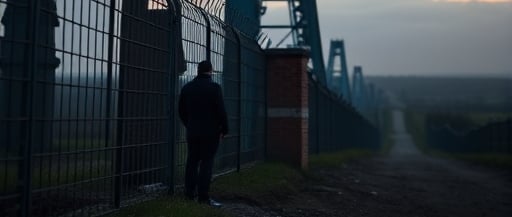Grappling with Hereik’s Faulty Immigration Policy
The divisions of the IIA are expected to persist long into the 21st-Century
HEREIK NEWSHEREIK
Reginald Noyt
1/13/20003 min read


When the URPH passed its landmark Immigration and Integration Act (IIA) in 1997, it was hailed by urban elites as a transformative step toward economic modernization. By opening Hereik’s borders, the government hoped to address labor shortages in manufacturing, boost economic productivity, and integrate the country into the broader Northern Albrean economy. Yet, while cities like Helvetia and Götheim reaped the benefits, rural regions—especially in the east—bore the brunt of the policy’s unintended consequences.
The legislation dramatically lowered barriers for migrants from Iliaq, Leode, and other Northern Albrean nations. By 2000, over 600,000 immigrants had arrived, many settling in urban centers where jobs in construction, manufacturing, and service industries awaited them. For western cities including then-URPH stronghold Apelzand, this influx was a boon. Factories expanded, new businesses opened, and the economy seemed to thrive. Immigrant communities introduced cultural diversity, reinvigorating city streets with new food, music, and traditions.
But the east, already struggling with economic stagnation, experienced a very different reality. For many small-scale farmers and dockworkers, the arrival of cheap labor created an unsustainable economic imbalance. Wages plummeted, competition for work intensified, and unemployment soared. Between 1998 and early 2001, unemployment in eastern regions like Melea and Rirani has risen from 10% to a devastating 16.3%, with many counties reporting even higher figures. The wheat industry, the backbone of the rural east, has been particularly hard-hit. Overproduction—enabled by migrant-staffed agribusiness—has driven wheat prices down by nearly 30%, forcing thousands of independent farmers into bankruptcy.
The collapse of the Hereik People’s Shipping Federation (HPSF) only deepened the crisis. Once a cornerstone of the eastern economy, the HPSF represented over 850,000 dockworkers at its peak, ensuring stable wages and a share of profits through cooperative ownership. But privatization policies under the URPH in the mid-1990s dismantled the federation, allowing foreign corporations to take control of Hereik’s ports. These firms replaced unionized workers with lower-paid immigrants, gutting local job security. By 2000, union membership among dockworkers had fallen to a dismal 20%, and wages in the sector had dropped by nearly 40%. Entire port towns in poorer parts of western Hereik have faced economic collapse, with once-thriving docks now dominated by foreign interests and precarious employment.
Socially, the effects of the IIA were just as divisive. Eastern communities, already marginalized by decades of underinvestment, felt alienated by the rapid cultural shifts brought on by immigration. Towns like Nazaraft and Bonale have witnessed unsustainable demographic changes, with little support from the government to ease tensions or foster integration. Promises of funding for language programs, cultural exchange initiatives, and job training—key components of the IIA—were quietly abandoned by 1999 as the URPH redirected resources to urban projects. This neglect only deepened the east’s sense of abandonment.
Critics of the URPH argue that the government’s priorities have been clear from the start: urban growth at any cost. While the west celebrated GDP growth of over 3% annually, the east languished in economic despair. The Amber Room, historically dominated by urban elites, ignored repeated calls from eastern representatives for targeted support. Instead, the government doubled down on deregulation, passing tax cuts for major agribusinesses and resource extraction companies. These policies disproportionately benefited the west, while leaving eastern communities to grapple with unemployment, environmental degradation, and cultural displacement.
The most damning indictment of the IIA is its failure to deliver on its promises of unity and progress. While the legislation succeeded in attracting foreign labor and boosting urban economies, it failed to address the deep regional inequalities that plague Hereik. The east’s struggles are not just an economic issue—they are a crisis of democracy. When entire regions feel excluded from national progress, the legitimacy of the government itself comes into question.
Now, as the Red-Blue-Black coalition enters its third month in power, it faces the monumental task of addressing the divisions left by the URPH. Some factions within the coalition propose a comprehensive rural development program, including subsidies for small farmers, infrastructure investments, and the restoration of union protections. Others advocate for stricter immigration controls and policies aimed at prioritizing local workers.
What is clear is that the status quo cannot continue. Hereik must confront the social and economic disparities that the IIA has exacerbated. This means not only investing in the east’s economic future but also fostering genuine integration between immigrant and native communities. The government must revive the IIA’s original vision by funding education, job training, and cultural exchange programs. At the same time, it must take bold steps to rebuild the east’s economic foundation, from revitalizing ports to supporting sustainable agriculture. Most critically, the Strength of Hereik Farmers (SHOF!) party must make good on its election promise to curb Northern Albrean immigration and allow Eastern Hereik to stabilize.
The IIA may have opened Hereik’s doors to the world, but it also exposed the fractures within the nation’s social fabric. If the new government fails to act, these divides will only deepen, threatening the stability of Hereik’s young democracy. It is time for a leadership that values Hereik’s citizens above urban advancement, and commits to a future of prosperity and stability.
